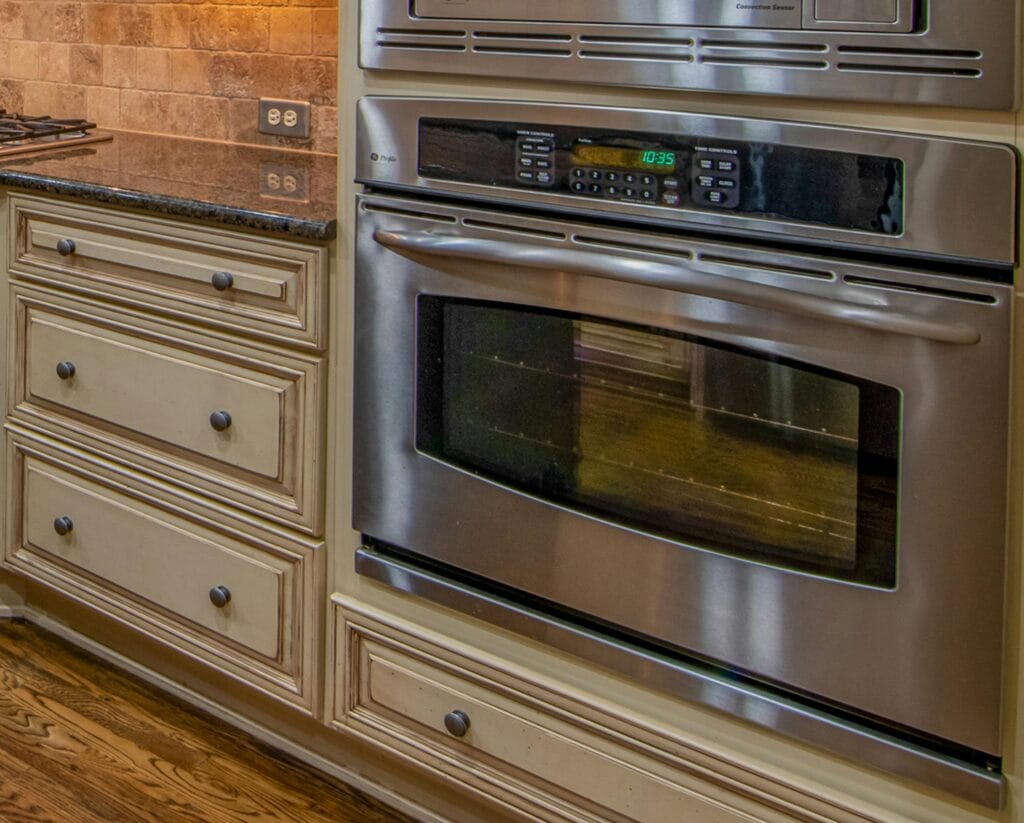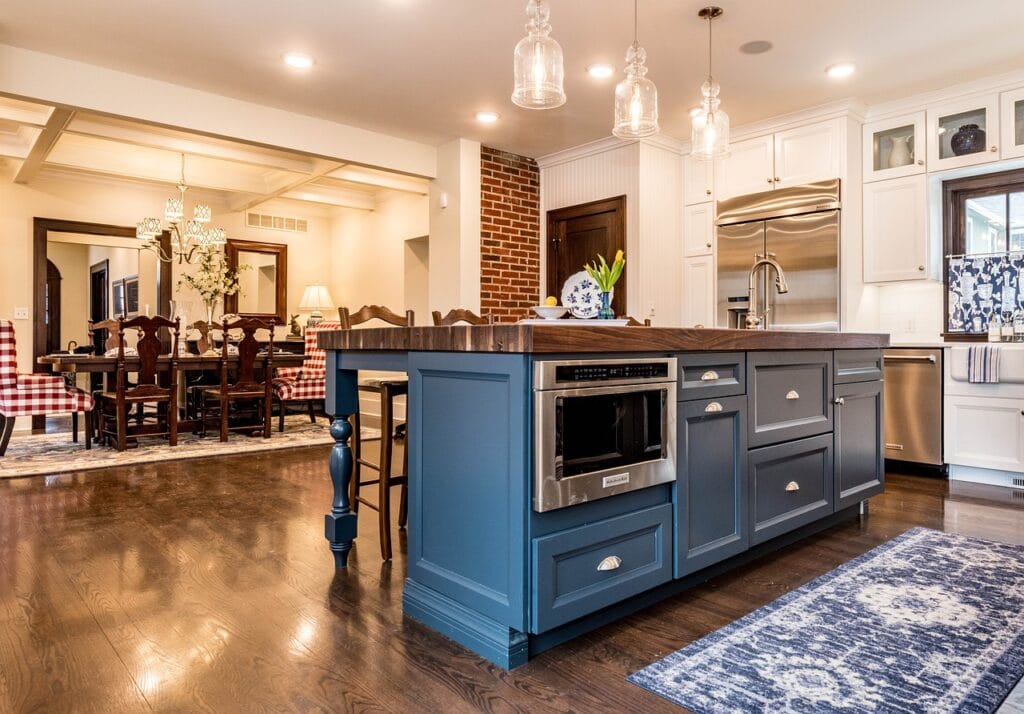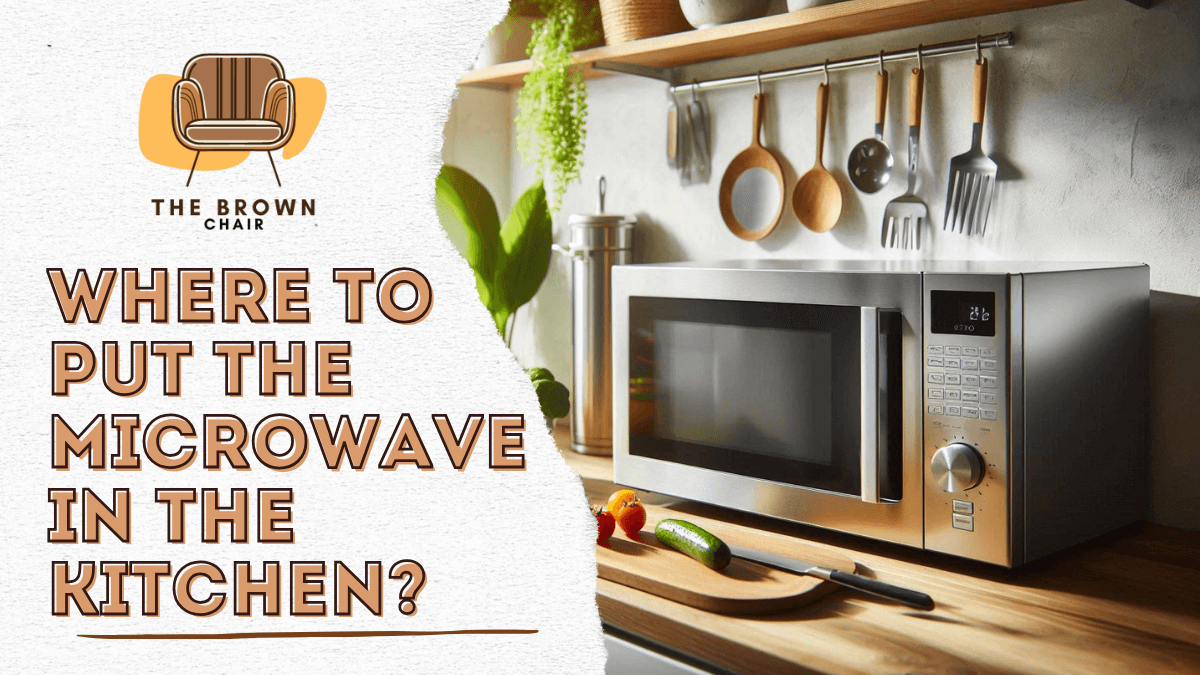When you’re setting up or remodeling your kitchen, one of the questions that might pop up is: Where to put the microwave in the kitchen? It’s one of those things you don’t think about until you’re standing there with a microwave in your hands, unsure where it’ll fit best in your beautiful new kitchen.
There’s no one-size-fits-all answer to microwave placement because every kitchen is different. Wherever you decide to place your microwave, make sure it’s easy to reach and use!
My kitchen experiences taught me that microwave placement can make a big difference. Let’s discuss some practical options for where to put your microwave, what to consider, and how to find the perfect spot for your kitchen.
Table of Contents
Bonus: Read our honest review of “5 Best Microwave Wall Oven Combo Units” if you are looking to buy a built-in microwave
Key Factors to Consider Before Choosing a Spot for Your
Microwave
The microwave is one of those appliances we rely on more than we realize. We use it constantly, whether for reheating last night’s pizza, defrosting chicken, melting butter, or quickly reheating coffee. But if it’s placed in an awkward spot, it can disrupt the flow of your kitchen and even become a hassle to use.

The Kitchen Work Triangle
Have you heard of the kitchen work triangle? It’s a classic design principle that suggests your stove, fridge, and sink should form a triangle for the maximum efficiency workflow. While the microwave isn’t part of this triangle, it plays an important supporting role.
Ideally, it should be placed in a location that doesn’t interrupt the flow between these three points but still offers easy access.
Convenience
Think of your kitchen as a busy road. You don’t want traffic jams when someone is trying to cook while another person is reheating food or trying to use different appliances.
Having your microwave in a spot that makes sense for your kitchen routine can make things run much smoother. You want it close enough to your prep area if you’re cooking, or near the dining space if it’s mostly used for heating meals.
Zones of the Kitchen
- Prep Zone: If you do a lot of cooking from scratch, having the microwave near your prep area is a good idea.
- Serving Zone: For families who mostly use it to reheat leftovers, placing the microwave near the dining area can make mealtime more convenient.
- Kid-Friendly Zone: If you have younger kids who need to use the microwave, placing it within their reach – without making it too low for adults – can be a challenge.
Safety Consideration
When it comes to safety, height is one of the most important factors. If you place your microwave too high or too low, you risk burns or spills from trying to lift hot items in and out of it.
This is especially true in homes with young kids or elderly family members. You don’t want someone stretching to reach boiling soup right?
On the other hand, there’s a lot of discussion about whether microwaves are radiation-safe. Some people worry about radiation or other health risks, but most experts agree that when used correctly, microwaves are safe.
I used to worry too but after doing a lot of research, I’ve felt much more comfortable using it, it saves time.
They work by emitting electromagnetic waves that cause water molecules in food to vibrate, generating heat – this process doesn’t make the food radioactive.
That said, you should always follow the manufacturer’s guidelines for proper use and maintenance. As long as your microwave is in good condition and you’re using microwave-safe containers, there’s very little risk.
If you’re still concerned about microwave safety, you might prefer to minimize its use by relying more on your stovetop or oven for cooking.
Aesthetic and Design Impact
Your kitchen’s overall look is another factor to keep in mind. Let’s be honest, microwaves aren’t exactly the most glamorous kitchen appliances. They can be bulky and disrupt the design flow of a sleek, modern kitchen if not placed properly.
But with some smart planning, you can make the microwave blend in with the rest of your space. If you prefer a clean, minimalist design (like me), is better for your microwave to be completely hidden in cabinetry or integrated into a wall.
Kitchen Layout and Size
Your kitchen’s layout and size will play a big role in determining the best spot for the microwave. In a smaller kitchen, counter space might be too valuable to sacrifice, which would make an over-the-range or built-in option more attractive.
In larger kitchens, you might have more flexibility to choose the perfect spot.
Ventilation Needs
Your microwave needs proper ventilation to function safely. Microwaves that double as range hoods can help circulate air and remove steam, smoke, and odors from the cooking area.
However, if your kitchen already has an external hood, you might not need this feature, which could open up other placement options.
Family, Couples, or Singles: What’s Your Lifestyle?
Your lifestyle plays a big part in how you use your kitchen, and that should influence where you place your microwave.
- Families: A microwave drawer or a built-in option at counter height can be great if you have kids, keeping it safe and accessible without cluttering the counter.
- Couples or Singles: For smaller households, countertops or over-the-range microwaves often make the most sense, especially if you’re working with limited kitchen space.
Busy Professionals: If you find yourself eating on the go or reheating leftovers often, having a microwave that’s easy to reach and near the fridge might make your life simpler.
8 Best Microwave Placement Options
There are several places you could put a microwave in the kitchen, each with its pros and cons. Let’s take a look at the most common options to help you decide which fits your lifestyle and kitchen layout.
1. Countertop Placement
My microwave is placed on the counter. We didn’t want to invest in anything built-in so we just found a corner on the counter for it. It works, but it always feels a little in the way, especially in a small kitchen.

This is probably the most common microwave placement option, especially for those who aren’t doing a full remodel. Simply placing the microwave on the counter is easy, affordable, and doesn’t require any special modifications. It’s especially common in kitchens where there isn’t a lot of cabinetry space.
Pros:
- It’s easy to move around if you change your mind.
Cons:
- It takes up precious counter space and can clutter the look of your kitchen so if you have a smaller kitchen, this might not be the best option.
When to Choose:
If you have a larger kitchen or don’t mind losing some counter space, this is the simplest and least expensive option.
2. Built-in or Above the Stove (Microwave at Eye Level)
For a more custom look, many homeowners opt for built-in microwaves that fit into their cabinetry. This creates a sleek, modern appearance and keeps the microwave off the counter. A built-in microwave is installed into your cabinetry, often at eye level or over the stove.

Placing the microwave over the stove is a classic choice because it combines two appliances into one space-saving area, especially in smaller kitchens. However, make sure you have enough clearance between the stove and microwave.
Too little space can make it harder to cook on the stovetop safely and be cautious – lifting hot food over your head isn’t always the safest option.
I think it’s best for homeowners who prioritize aesthetics and can afford the investment. Maybe one day I will change my mind and choose this option because I like free space.
IMPORTANT: Over-the-range microwaves come with built-in ventilation, that doubles as a hood for your stovetop but if you’re going with the built-in option, make sure the area is well-ventilated to avoid overheating the appliance. If your microwave will be near a stovetop, proper ventilation is essential. Even if you’re not placing the microwave above the stove, it’s important to consider airflow. If you opt for a countertop microwave, leave enough space around the sides and back for proper ventilation.
Pros:
- Saves counter space.
Cons:
- Expensive to install, and may require custom cabinetry. Also, it can be tricky if you’re on the shorter side or have kids who need to use it.
3. Microwave Drawers
One of the more recent trends is the microwave drawer which is popular in modern high-tech kitchens. It’s built into the lower cabinets and pulls out like a drawer, making it super easy to use without bending down or reaching up.
This option is perfect for people with accessibility needs.

Pros:
- Easier to access for people with mobility issues.
Cons:
- It’s expensive and may require professional installation and custom cabinetry.
4. Under the Kitchen Island
When it comes to maximizing space and creating a seamless kitchen design, installing a microwave under the kitchen island is one of the more practical solutions out there while making the microwave easily accessible at a lower height.

Imagine walking through your kitchen with everything at arm’s reach – while your microwave is hidden yet easily usable.
Pros:
- It’s easy to access without much reaching or bending, making it a convenient choice for everyday use.
Cons:
- It requires careful planning custom cabinetry, or a kitchen island with enough storage.
5. On Top of a Washing Machine
If you have a combined kitchen and laundry area, placing your microwave on top of the washing machine can be a surprisingly effective way to save space.
In homes where every inch counts, especially in smaller apartments or homes with tight layouts, this can be an amazing solution that makes use of available space without crowding your countertops.

My mom’s microwave is on top of the washing machine, and it’s a pretty handy setup for her. The only funny thing is that when the washing machine hits the spin cycle, the microwave does a little dance and shakes around!
While it’s not dangerous, it does make you double-check that nothing fragile is sitting on top like some forgotten mug. It’s something to think about if you’re considering this option.
Pros:
- Keeps the microwave off the countertop, leaving more room for food prep and other appliances.
Cons:
- The vibrations could cause the microwave to rattle, especially during the centrifuge cycle.
6. Install It in the Pantry
If your pantry has a bit of extra room, placing your microwave inside is a great way to keep it hidden while still easy to reach when you need it. Just keep in mind that if the pantry is far from your main cooking area, it might feel a bit inconvenient running back and forth while prepping meals.

Pros:
- Frees up kitchen space.
Cons:
- Keep in mind that if the pantry is far from your main cooking area, it might feel a bit inconvenient running back and forth while prepping meals.
7. On a Floating Shelf
Placing your microwave on a floating shelf is a simple yet stylish way to keep it off your countertop without sacrificing accessibility. The flexibility of installing the shelf at any height makes this option highly customizable, whether you need it lower for easy reach or higher to keep it out of the way.

Pros:
- Adds a modern touch to your kitchen design.
Cons:
- Requires strong, properly installed shelving to support the microwave’s weight and ensure stability.
8. Hidden in a Cabinet or Appliance Cupboard
If you have a cabinet that’s not being fully utilized, you could convert it into a built-in microwave nook. This works best if you have deep cabinets or an extra-large pantry. The best part is that it stays hidden when not in use, helping to maintain a streamlined kitchen.

Pros:
- Keeps your kitchen looking neat and organized, with no visible appliances cluttering up the counters.
Cons:
- You’ll need to open the cabinet doors each time you use it, and ensure there’s proper ventilation to prevent overheating.
Where NOT to Put Your Microwave
Now that I’ve covered the ideal spots, let’s talk about places that are better avoided for safety, functionality, or efficiency reasons. While some spots may seem convenient at first, they can cause long-term issues.
Avoid Angled Corners

Yes, using an angled cabinet for your microwave is a clever way to make use of what can often be a wasted or awkward space in your kitchen. By placing the microwave in one of these tricky spots, you free up valuable countertop space while putting that corner to use but it can cause more problems than it solves.
Especially in smaller kitchens, the angled can feel like dead zones where things either get cluttered or are difficult to reach.
It can make the microwave hard to reach, and reduce visibility, or it’s easy to open and close.
Next to a Fridge Or Top of the Fridge

Placing a microwave right next to your refrigerator might seem like a convenient setup, but it can interfere with both appliances.
The microwave can cause the fridge to work harder by raising the surrounding temperature leading to higher energy bills and potentially shorter appliance lifespans.
Microwave Next to a Sink – Too Close to Water!!!

Placing a microwave next to your kitchen sink might sound practical, but it’s not recommended. Water and electronics are never a good mix, and the risk of water splashes or short circuits can be dangerous.
Avoid if you have limited space near the sink. Opt for placing it further away to keep the microwave dry and safe.
Next to a Window

Positioning your microwave near a window might seem appealing, but it exposes the appliance to direct sunlight and temperature changes. Over time, this can affect its performance and can damage the microwave’s internal components.
Don’t Place Too High

Placing the microwave too high can make it difficult and unsafe to use, especially when lifting heavy or hot dishes. Remember, if you find yourself on your tiptoes, the microwave is too high. A good rule of thumb is to ensure the bottom of the microwave is no higher than shoulder height.
Crowded Spaces

Don’t squeeze the microwave into a tight space. If your microwave is pressed between cabinets with no room to breathe, it can overheat. Plus, it’s less convenient to use.
How to Decide Where to Place a Microwave in Your Kitchen
Finding the perfect spot for your microwave might feel overwhelming, but asking yourself a few key questions can simplify the decision. Here are some factors to consider,
What Type of Cooking Do I Do Most Often?
Your cooking habits can influence the microwave’s placement. If you often use the microwave placing it close to the stove or food prep area ensures you can easily transition from microwaving to cooking.
Do I Have Young Kids?
If you have little ones at home, safety is a priority. You’ll want to place the microwave out of their reach or ensure it’s at a height where they can safely use it with supervision.
If your kids are ages 3 to 8, consider installing the microwave under the kitchen island or in a pantry where they can’t easily access it without help.
How Often Do I Use My Microwave?
The frequency of use is one of the most critical factors to consider. If you find yourself reaching for the microwave several times a day, you’ll want it to be in a highly accessible spot.
If you’re a busy parent who often reheats leftovers or warms up snacks for the kids, placing the microwave on the countertop or in an easily reachable cabinet makes sense.
Do I Use Other Kitchen Appliances Frequently?
If you regularly use other appliances, consider how the microwave’s location may impact your cooking routine. If your toaster and coffee maker are on the counter, placing the microwave nearby can create a compact cooking zone.
Am I Looking to Save Space?
If you’re tight on space, you may need to get creative with where you place the microwave. If counter space is limited, consider placing the microwave in the pantry or under the kitchen island to keep it out of sight but still within reach.


 ChatGPT
ChatGPT
 Perplexity
Perplexity
 Claude
Claude
Leave a Reply